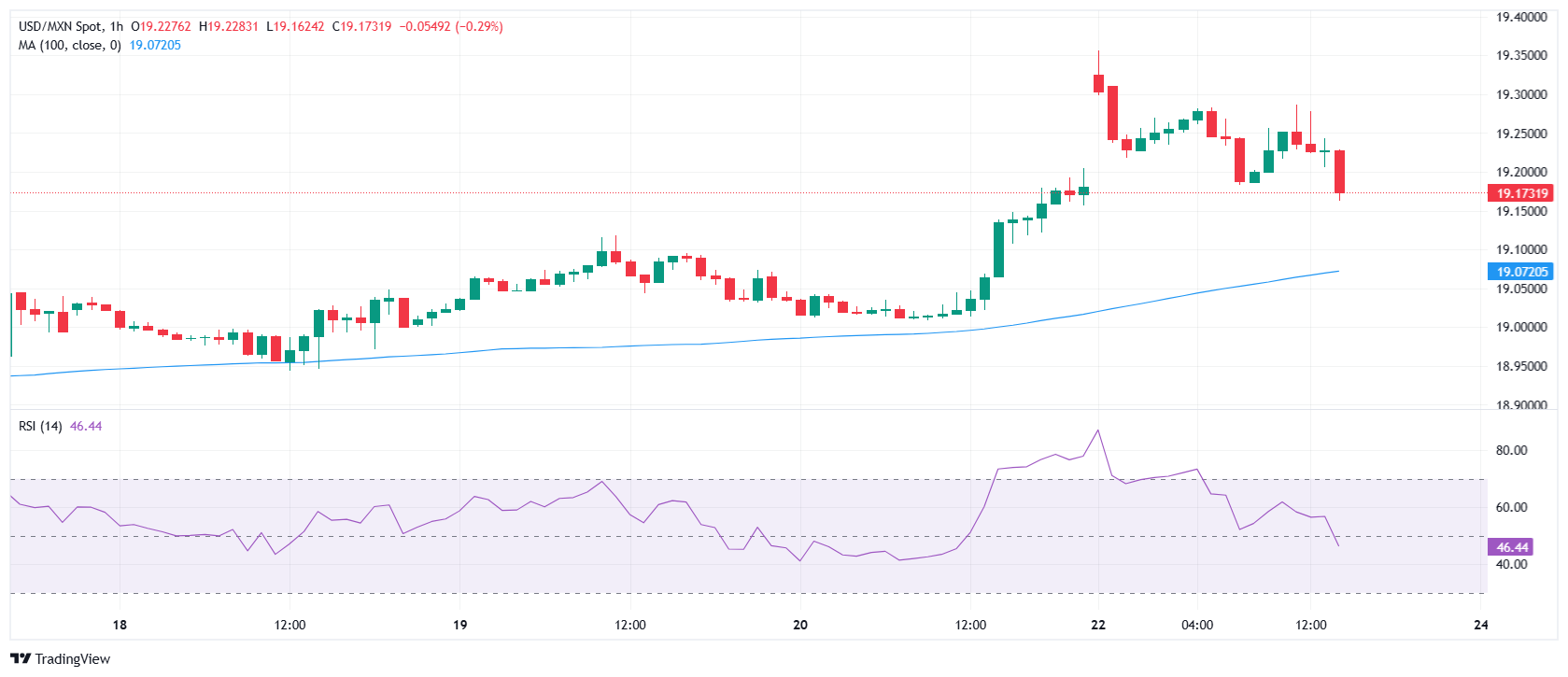- The USD/MXN has risen on Monday to a maximum of three weeks in 19.35 after US attacks to Iran, but has lost all day gains after the American opening.
- The US dollar regained its role as a safe refuge in the first part of the day, subsequently weakening after the Fed Flexibilization comments.
- Several Fed members suggest an interest rate cut in July.
- The retail sales of Mexico fall in April while the PMIs Americans improve forecasts in the preliminary reading of June.
The USD/MXN has begun the day with a strong climb to three -week maximums in 19.35, driven by the United States attack on Iran on Sunday. After the American Opening, the Fed comments in favor of a rate cut in July have sent to the torque to a minimum daily in 19.16, where at the time of writing it loses 0.07% daily.
The US dollar reaches its highest level in June after the US attack to Iran but yields all earnings after the Fed Flexibilization comments
The US dollar index (DXY) has been considerably appreciated this Monday after the United States attacks on Iranian nuclear facilities carried out on Sunday. The green ticket has risen to 99.42 in the first part of the day, its highest level since last May 30, but has lost strength in the last hours, sliding to 98.70 and quoting in these moments in red, with slight daily losses.
The United States bombed three nuclear facilities of Iran yesterday, specifically those of Fordo, Isfahán and Natanz. The same American president Donald Trump communicated the news through Truth Social, where he said that “this is a historical moment for the United States, Israel and the world. Iran must now accept ending this war.”
Iran reacted to the attacks by launching an offensive with missiles against Israel in which more than 85 people were injured. In addition, one of the Iranian army spokesmen, Ebrahim Zolfaqari, warned that the US should expect serious consequences for their actions.
Meanwhile, the markets wait tense at the threat of Iran to close the Ormuz Strait, which would affect the oil supply and prices, since 20% of the world crude passes through this route. In this context, the dollar gained ground compared to the main currencies, including the Mexican peso, although it has lost all the impulse after the comments in favor of a prompt flexibility of the Fed by several members of the entity.
Michelle BowmanVice President of Supervision of the United States Federal Reserve, has declared in the last hour that It is favorable that the entity cuts its interest rates as soon as in the July meeting if the inflationary pressures are contained. These statements have weakened the dollar, also adding to the words of Christopher Waller, a member of the Fed, who on Friday assured that the Central Bank could lower the types in July.
Mixed US data and Mexico
Mexico has published its retail sales figures today. The indicator fell 1% monthly in April after rising 0.5% in March, falling for the first time after four months in a row. At the year -on -year, the Retail sales fell 2% after growing 4.3% the previous month, showing their greatest decrease in ten months.
The data has not favored the Mexican peso, which tomorrow awaits the publication of Mexico’s inflation in the first half of June. The market awaits a 0.12% rise compared to the previous 0.09%, while for the underlying indicator, which excludes food and energy, a 0.18% increase is expected from the previous 0.16%.
In the United States, today the Preliminary Global S&P PMI data. The services indicator has fallen to 53.1 points in May since April 53.7, although it has improved the expected 52.9. The manufacturing PMI has remained unchanged in 52, exceeding the 51 provided by the consensus.
Later, the existing housing sales data in the US has been published in May, showing a growth of 0.8% after having fallen 0.5% in April. The result improves the 1.3% descent estimated by the market.
USD/MXN Price levels
The relative force index (RSI) has fallen below 50 in the time graph, pointing to more descents in the short term. In the case of extending the setback, the first support appears on 19.07/19.04, mobile average of 100 periods in the graph of one hour and four hours, respectively. A break in this region would lead to the torque around 18.82, a 2025 floor reached last week.
Upwards, a rupture above the maximum of three weeks marked today in 19.35 could accelerate an ascent around 19.78, May roof recorded on day 6 of that month.
Usd/mxn one hour graphic

Mexican weight FAQS
The Mexican weight (MXN) is the most commercialized currency among its Latin American peers. Its value is widely determined by the performance of the Mexican economy, the country’s central bank policy, the amount of foreign investment in the country and even remittance levels sent by Mexicans living abroad, particularly in the United States. Geopolitical trends can also affect MXN: for example, the Nearshoring process (or the decision of some companies to relocate the manufacturing capacity and supply chains closer to their countries of origin) is also considered a catalyst for the Mexican currency, since the country is considered a key manufacturing center in the American continent. Another catalyst for MXN is oil prices, since Mexico is a key exporter of the raw material.
The main objective of the Central Bank of Mexico, also known as Banxico, is to maintain inflation at low and stable levels (in or close to its 3%target, the midpoint of a tolerance band between 2%and 4%). To do this, the bank establishes an adequate level of interest rates. When inflation is too high, Banxico will try to control it by raising interest rates, which makes the indebtedness of homes and companies more cooling, thus cooling the demand and the economy in general. The highest interest rates are generally positive for Mexican weight (MXN), since they lead to higher yields, which makes the country a more attractive place for investors. On the contrary, lower interest rates tend to weaken the MXN.
The publication of macroeconomic data is key to evaluating the state of the economy and can have an impact on the valuation of the Mexican weight (MXN). A strong Mexican economy, based on high economic growth, low unemployment and high confidence is good for MXN. Not only attracts more foreign investment, but it can encourage the Bank of Mexico (Banxico) to increase interest rates, particularly if this fortress is accompanied by high inflation. However, if the economic data is weak, the MXN is likely to depreciate.
As an emerging market currency, the Mexican weight (MXN) tends to rise for periods of risk, or when investors perceive that the general market risks are low and, therefore, are eager to participate in investments that carry a higher risk. On the contrary, the MXN tends to weaken at times of market turbulence or economic uncertainty, since investors tend to sell higher risk assets and flee to the most stable safe shelters.
Source: Fx Street
I am Joshua Winder, a senior-level journalist and editor at World Stock Market. I specialize in covering news related to the stock market and economic trends. With more than 8 years of experience in this field, I have become an expert in financial reporting.







